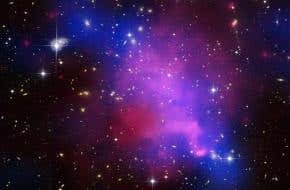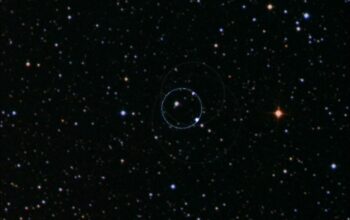The cosmos is vast and enigmatic, its secrets often shielded from human understanding by the ironclad laws of physics. Among the myriad celestial phenomena that beckon the curiosity of astrophysicists, perhaps none are as perplexing as the elusive concept of dark matter. Central to many astronomical narratives, dark matter has long been posited as the invisible scaffolding that underpins the structure of galaxies and clusters, constituting nearly 27% of the universe’s total mass-energy content. However, recent observations of a cosmic ‘train wreck’ have thrown this established paradigm into disarray, prompting an urgent re-evaluation of dark matter theories.
In astrophysics, a “train wreck” denotes a catastrophic astrophysical event involving the violent interaction of cosmic structures. In this particular instance, researchers have uncovered a remarkable instance of galaxy cluster collision, showcasing a spectacle of chaos that highlights the limitations of current theoretical frameworks regarding dark matter. This intergalactic melee provides an unprecedented opportunity to interrogate the fundamental assumptions surrounding dark matter. Yet what sparked this intrigue, and how does this collision inform our understanding of the universe?
To comprehend the implications of this cosmic encounter, one must first grasp the conventional underpinnings of dark matter theory. According to the most widely accepted cosmological models, dark matter is the unseen mass that exerts gravitational influence on visible matter, thereby facilitating the formation of galaxies and clusters. Observational evidence—including gravitational lensing, the cosmic microwave background radiation, and galaxy rotation curves—has long supported the existence of this enigmatic substance. However, this new finding has raised eyebrows among scholars, as the collision dynamics challenge the canonical view of dark matter’s role in cosmic evolution.
The event in question, marked by the chaotic interactions between two massive galaxy clusters, reveals a striking dissonance between the observed behaviors of baryonic matter and the expected behavior of dark matter. As these clusters collided, the hot gas, which accounts for the visible matter in the clusters, was observed to slow down and exhibit a distribution that deviated from predictions made by dark matter simulations. What was particularly startling was the apparent lack of the gravitational imprint one would expect from dark matter in the same region, effectively rendering a portion of the standard model obsolete.
This remarkable observational occurrence compels physicists to reconsider several cornerstone concepts. For one, the principle of gravitational lensing, which relies on dark matter to explain the warping of light around massive objects, appears to have inconsistencies when juxtaposed with the data obtained from this cosmic dance. The discrepancies hint at the possibility that dark matter might not be as omnipresent as previously believed, or that alternative theories of gravitation, such as modified Newtonian dynamics (MOND), could be more applicable in certain realms of observation.
Furthermore, as scientists sift through the remnants of this cosmic collision, several tantalizing questions arise. If dark matter is indeed an insufficient explanatory framework, what constitutes the true essence of the universe’s mass-energy content? Could there be entirely novel particles or forces at play that we have yet to identify? Perhaps it is time for a paradigm shift—one that embraces the uncharted realms beyond our current comprehension. With the complexities of quantum theories intertwining with cosmological observations, interdisciplinary approaches may lead us to revolutionary understandings.
Moreover, the implications of such fundamental revisions in our cosmological models extend beyond theoretical physics and into the realm of astronomy. The pursuit of answers invites a reinvigorated approach to observational strategies, emphasizing the necessity of technological advancement in telescopes and detection methods. As academic institutions rally to design next-generation observational equipment, the field stands on the precipice of a new era, ripe for exploration and discovery. Researchers are compelled to investigate merging phenomena under various conditions, expanding beyond traditional dark matter parameters to explore novel physics that might govern interaction outcomes.
As we endeavor into the complexities unearthed by this cosmic train wreck, it is prudent to consider the broader philosophical implications entwined with our quest for knowledge. The humble pursuit of understanding the universe is at times fraught with uncertainty and paradigm shifts. The exploration of phenomena such as this collision not only refines our grasp of cosmic composition but also weighs heavily on the narrative arc of scientific progress. The fusion of observation, theory, and philosophical inquiry allows humanity to dwell at the threshold of the unknown, beckoning us to question not just dark matter but the very foundations of how we interpret the universe itself.
In summary, the recent observations of a cosmic train wreck embody both a challenge and an opportunity within the field of astrophysics. The divergence of observed behaviors from expected patterns forces scholars to reevaluate the dark matter paradigm, urging us to conceptualize alternate frameworks that might elucidate our understanding of cosmic phenomena. As science ambles forward into the uncharted territories of understanding, let us remain inquisitive and vigilant, guiding future explorations illuminated by the lessons learned from the celestial ballet of colliding galaxies. The cosmos, in its vastness, persistently beckons; the journey toward comprehension is far from over.










